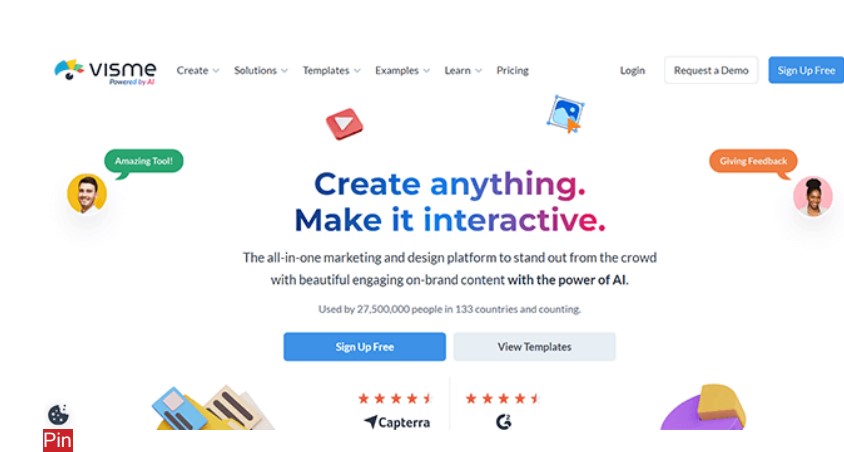6 Best Online Graphic Design Tools
For 2024 (Free + Paid)
Looking for the best online graphic design tools? I’ve got you covered.
I’ve tried out all the most popular web-based graphic design tools so that you don’t have to.
In this post, I’ll be reviewing and comparing each of them in detail.
I’ll discuss what kind of graphics you can make with each of them, share my take on their pros and cons, explain how pricing works, and tell you everything else you need to know.
#1 – Viseme
Visme is the best online graphic design tool for most users but especially marketers. I’ve seen it described as ‘like Canva on steroids’, and I think that’s a pretty accurate description.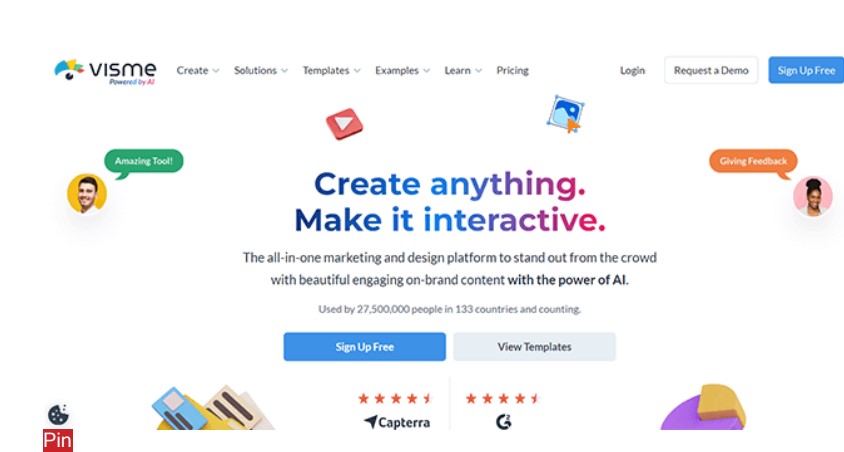
It’s a web-based design tool that you can use to create all sorts of professional quality visual assets with the help of a huge library of templates and royalty-free images—no graphic design skills necessary.
You can make literally anything you can think of: Social media graphics, infographics, charts and graphs, presentations, slides, eBook’s, newsletters, white papers, lead generation forms… even 3D graphics and animations.
It’s way ahead of the curve when it comes to AI too. The built-in AI designer can generate assets for you on the fly based on your text prompts, which saves a ton of time.
And I particularly like the AI-powered image suggestion tool. If you want to change a photo that you’ve used in your design, just click ‘Replace’ and the AI will provide a range of similar, alternative stock images for you to choose from. You won’t find anything similar to this in Canva, or anywhere else, but it’s super useful.
In total, there are 14,000 templates on Visme to choose from, but they’re all made by Visme’s in-house design team, and as a result, they’re all very high-quality.
In contrast, competitor tools like Canva come with more templates, but they’re sourced from external contributors, so the quality is hit-and-miss.
Key features
![]() Graphic design tools. Visme comes with around a dozen design tools including a video maker, timeline maker, GIF maker, newsletter maker, printables maker, eBook creator, and more.
Graphic design tools. Visme comes with around a dozen design tools including a video maker, timeline maker, GIF maker, newsletter maker, printables maker, eBook creator, and more.
![]() Visme AI. Utilize artificial intelligence to save time with Visme’s AI designer, Presentation Maker, Document Generator, Image Generator, etc.
Visme AI. Utilize artificial intelligence to save time with Visme’s AI designer, Presentation Maker, Document Generator, Image Generator, etc.
![]() Templates. Choose from thousands of templates for everything from social media graphics to data visualizations, and everything in between.
Templates. Choose from thousands of templates for everything from social media graphics to data visualizations, and everything in between.
![]() Find and use photos, mockups, icons, and other creative assets in your designs.
Find and use photos, mockups, icons, and other creative assets in your designs.
Pros and cons
![]() All-in-one graphic design & marketing platform
All-in-one graphic design & marketing platform![]() Build any type of visual asset you can think of
Build any type of visual asset you can think of![]() Large catalog of professionally made templates
Large catalog of professionally made templates![]() Suitable for marketers and agencies
Suitable for marketers and agencies![]() Best-in-class AI tools
Best-in-class AI tools![]() More expensive than other tools but worth it
More expensive than other tools but worth it![]() Video editor is less intuitive than some other tools
Video editor is less intuitive than some other tools
Pricing
Free plan available. Paid plans start from $29/month, save 50% when you pay yearly.
#2 – Canva
Canva is by far the most popular free graphic design software on the market—and for good reason. It’s stupidly easy to use and light years ahead of every other graphic design tool in terms of UX. And its asset library is enormous.
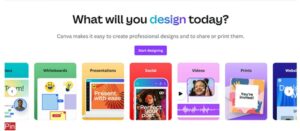
The whole point of Canva is to make graphic design accessible to the general public, and it does a fantastic job of that. You need zero skills to get started, and you don’t need to draw anything yourself (unless you want to). You just drag and drop pre-fabs that other designers have created and then customize them.
I’ve found that it’s particularly good for pumping out social media graphics as it has millions of editable templates for every network and format. The editor itself is very smooth and runs in your web browser so you don’t need to download anything.
Sure, there are some design limitations. You can’t edit with the kind of freedom you can in industry-grade software like Adobe Photoshop and Adobe Illustrator. You’ll pretty much just be changing the size, color, and position of elements—you can’t deform them or precision edit.
And it’s not the best tool if you plan on printing your designs either. I’ve noticed that you can’t easily customize things like margins, bleeds, and gutter space. Likewise, a lot of stuff on Canva is low-res RGB, and CMYK colors often don’t reproduce accurately.
Still, what you lose in design freedom and print quality you make up for in other ways, like speed and ease of use.
And frankly, Canva’s huge asset library alone is reason enough to justify signing up. You can get stock images, music, animations, and vector graphics on Canva at a tiny fraction of the cost of any stock site. So, to be honest, even if you used it for nothing other than getting stock assets, it would still be a complete steal.
Key features
![]() Free graphic design tool. Create your designs for free in Canva’s drag-and-drop visual editor, with customizable dimensions.
Free graphic design tool. Create your designs for free in Canva’s drag-and-drop visual editor, with customizable dimensions.
![]() Editable templates. Choose from hundreds of thousands of templates for any design imaginable, including social media templates, blog banners, etc.
Editable templates. Choose from hundreds of thousands of templates for any design imaginable, including social media templates, blog banners, etc.
![]() Elements. Browse millions of prefab graphics and other visual assets and add them to your designs.
Elements. Browse millions of prefab graphics and other visual assets and add them to your designs.
![]() Draw. Design your own graphics and create illustrations from scratch with the Draw tool.
Draw. Design your own graphics and create illustrations from scratch with the Draw tool.
![]() AI tools. Generate images from text prompts and use the Magic Edit brush to modify your photos using the power of AI.
AI tools. Generate images from text prompts and use the Magic Edit brush to modify your photos using the power of AI.
Pros and cons
![]() The best UX of any online graphic design tool
The best UX of any online graphic design tool![]() Huge library of templates, graphics, stock images, and other visual assets
Huge library of templates, graphics, stock images, and other visual assets![]() Creating ‘good-enough’ graphics in Canva takes a fraction of the time it would take in Adobe CC.
Creating ‘good-enough’ graphics in Canva takes a fraction of the time it would take in Adobe CC.![]() Generous free plan that lets you create and download an unlimited number of projects
Generous free plan that lets you create and download an unlimited number of projects![]() Not great for prints
Not great for prints![]() Some design limitations compared to professional software
Some design limitations compared to professional software![]() They occasionally move free features into the premium version
They occasionally move free features into the premium version![]() A lot of the better graphics are Premium.
A lot of the better graphics are Premium.
Pricing
Free plan available. Paid plans start from $12.95/month, save money when you pay yearly. Get started with a 30-day free trial.
#3 – Placeit
Placeit is a graphic design tool owned by Envato, the leading online marketplace for creative assets. So, as you’d expect, it has lots of great community-made templates and graphics. It’s also my go-to tool when I want to create product mockups for social media.
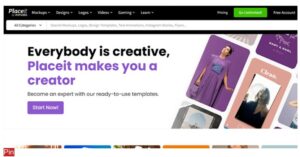
Placeit offers the largest collection of mockup templates on the internet. You just drag and drop your designs on them to create modeled product shots and videos, which you can then share on Instagram, Pinterest, and so on.
This is super useful for print-on-demand sellers who aren’t able to take physical photos of the products they sell and need to generate them instead.
One feature I particularly like is Placeit’s Brand Kits. It lets you add your logo and choose your brand colors and fonts, then save that so you can apply your branding to any template on PlaceIt in a couple of clicks. This saves a lot of time.
That’s it for the good stuff, now let’s talk about the bad.
Placeit’s drag-and-drop editor seems to be slower and less responsive than Canva and Visme. I’ve found that I often have to wait a few seconds after clicking something for the design to update.
It’s not very flexible either. You’re limited to adding graphics and text to the page and then changing the color and size. It can’t do much more than that, and there’s no easy way to reorder layers without deleting them and reading them as far as I can see.
The other issue is that because Placeit is so popular for product mockups, you might find your competitors will use the same templates for their photos, so you end up with the same models in your shots.
Key features
![]() Templates. Start by choosing a template for your graphics from Placeit’s library, which includes the biggest selection of product mockup templates on the market.
Templates. Start by choosing a template for your graphics from Placeit’s library, which includes the biggest selection of product mockup templates on the market.![]() Editor. Edit your templates to create product mockups and social media posts in the drag-and-drop editor.
Editor. Edit your templates to create product mockups and social media posts in the drag-and-drop editor.![]() Graphics. Add graphics from Placeit’s asset library to your designs or upload your own.
Graphics. Add graphics from Placeit’s asset library to your designs or upload your own.![]() Brand Kits. Create and save your own brand kit so you can add your branding to templates in one click.
Brand Kits. Create and save your own brand kit so you can add your branding to templates in one click.
Pros and cons
![]() The best graphic design tool for product mockups
The best graphic design tool for product mockups![]() Place graphics as overlays to create realistic-looking designs
Place graphics as overlays to create realistic-looking designs![]() Brand Kits is a great time-saving feature
Brand Kits is a great time-saving feature![]() Very easy to use
Very easy to use![]() Not much design/editing freedom
Not much design/editing freedom![]() The editor can be laggy and sluggish
The editor can be laggy and sluggish![]() UX could be improved
UX could be improved
Pricing
Free plan available. Paid plans start from $9.99/month billed yearly.
#4 – Adobe Express
Adobe Express is the best choice for professional designers. Imagine Canva but with a little more dignity.
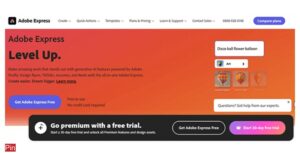
It bridges the gap between professional graphic design software like Photoshop and Illustrator and more beginner-friendly online tools. The interface is similar to Lightroom. But of course, it runs in your web browser rather than on your desktop, so you don’t have to download anything.
It’s simple, fast, and accessible enough for beginners, but also flexible enough for designers to work with.
You can edit individual elements with more freedom and do things like apply blends to affect how layers interact. For photo editing, you can adjust sliders to tweak the contrast, brightness, highlights, etc.—the sort of stuff you can’t do on most other online tools.
It’s linked up with your Adobe library so you can pull in PS and AI assets that you’ve already made in Adobe CC—I’m sure you can imagine how that might come in useful. You can also collaborate on designs and comment on files in real time, which is a huge benefit if you’re working as part of a larger team.
The downside? Well, it’s pretty laggy—I had to wait 10+ seconds for a new project to load up. It doesn’t come with as many templates and creative assets as you get with Canva either. And it’s not quite as easy to use as some of the other online graphic design tools in this list. There may be such a thing as too many features.
Key features
![]() Online graphic design tool. Create Instagram Reels, TikTok videos, blog banners, brand logos, and more in Adobe’s free tool for graphic designers.
Online graphic design tool. Create Instagram Reels, TikTok videos, blog banners, brand logos, and more in Adobe’s free tool for graphic designers.![]() Templates & creative assets. Choose from thousands of professionally designed templates and utilize Adobe Stock photos, music, and videos in your projects.
Templates & creative assets. Choose from thousands of professionally designed templates and utilize Adobe Stock photos, music, and videos in your projects.![]() Team collaboration. Collaborate with other designers on projects, leave comments, and more.
Team collaboration. Collaborate with other designers on projects, leave comments, and more.![]() One-click tasks. Remove backgrounds, resize images, trim video clips, and more with a single click.
One-click tasks. Remove backgrounds, resize images, trim video clips, and more with a single click.![]() Adobe Firefly. Use Adobe’s built-in generative AI tool to instantly make text effects and images from your text prompts.
Adobe Firefly. Use Adobe’s built-in generative AI tool to instantly make text effects and images from your text prompts.
Pros and cons
![]() Well-suited to both beginners and professional designers
Well-suited to both beginners and professional designers![]() More flexible than other web-based design tools and offers more design freedom
More flexible than other web-based design tools and offers more design freedom![]() You can collaborate on projects with your team
You can collaborate on projects with your team![]() Integrates with Adobe CC products
Integrates with Adobe CC products![]() Some powerful AI and one-click editing tools
Some powerful AI and one-click editing tools![]() Could be easier to use
Could be easier to use![]() Can be slow to load
Can be slow to load![]() Not as many templates or graphics as Canva
Not as many templates or graphics as Canva
Pricing
Free plan available. Paid plans start from $9.99/month, save 16% when you pay yearly. Get started with a 30-day free trial.
#5 – Snappa
Snappa is an online graphic design tool built for marketers. You can use it to create graphics for social media, blogs, and online ads quickly and easily.
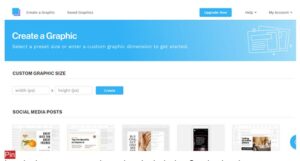
It works the same way as other tools we’ve looked at: Start by choosing a customizable template and edit it in the drag-and drop builder. Not much difference there.
But what makes Snappa special is its focus on ease of use and speed. The developers seem to have taken a ‘less is more’ approach, and that’s to its credit.
It doesn’t have nearly as many templates as you get with Canva, and you won’t find templates for things like birthday cards or restaurant menus. It focuses exclusively on providing creative assets that its target audience of marketers would find useful.
The upshot of that is that it feels much less ‘bloated’ than other tools, so it’s easier to find what you need quickly. Of course, the flip side is that you don’t have as many options to choose from. In particular, there aren’t many graphics and shapes, and the available icons and vectors are very basic.
Another thing I like about Snappa is its one-click dimension presets—they come in super useful when you’re creating graphics for social media.
For example, let’s say you’ve just created an Instagram post and you want to also pin it on Pinterest. In one click, you can resize it to fit Pinterest’s dimensions. This is something you can’t easily do on Canva as it requires a Premium subscription to change dimensions after you’ve already started a project.
Key features
![]() Templates. Choose from around 6,000 templates for common marketing designs like social media graphics and blog cover images.
Templates. Choose from around 6,000 templates for common marketing designs like social media graphics and blog cover images.![]() Drag-and-drop builder. Customize your templates and create custom graphics in the intuitive drag-and-drop editor.
Drag-and-drop builder. Customize your templates and create custom graphics in the intuitive drag-and-drop editor.![]() Stock photos. Browse a library of over 5 million high resolution, royalty free stock photos and use them in your projects.
Stock photos. Browse a library of over 5 million high resolution, royalty free stock photos and use them in your projects.![]() One-click resizing. Resize projects in one click using preset dimension presets for all the most common social media post formats.
One-click resizing. Resize projects in one click using preset dimension presets for all the most common social media post formats.
Pros and cons
![]() Fast, simple, and easy to use
Fast, simple, and easy to use![]() Good selection of templates for marketers
Good selection of templates for marketers![]() One-click dimension presets for all social media platforms
One-click dimension presets for all social media platforms![]() Integrates with Buffer for easy social media publishing
Integrates with Buffer for easy social media publishing![]() Provides a huge library of high-res stock photos
Provides a huge library of high-res stock photos![]() Not as many templates or graphics as other graphic design tools
Not as many templates or graphics as other graphic design tools![]() Design limitations
Design limitations
Pricing
Free plan available. Pro plans start from $15/month, save 33% when you pay yearly.
#6 – Stencil
Stencil is another graphic design tool that’s essentially a ‘lighter’ version of Canva. Its target users are brands, marketers, and bloggers.
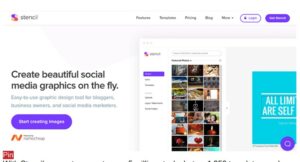
With Stencil, you get access to over 5 million stock photos, 1,350 templates, and 3.1 million icons and graphics. That might not be as many as Visme or Canva, but it’s enough to get on with.
I like the user interface a lot, and I’ve found it affords a little more design freedom than similar tools.
For example, you aren’t limited to just dragging and dropping elements and changing the size and color. There are also lots of sliders to change things like color overlay, transparency, blur, etc. of individual elements, plus filters and all the other essentials.
I also like the fact that Stencil offers a WordPress plugin. It comes in handy for bloggers as you can create images from inside WP to use in your posts and pages.
And if you’re creating posts for social media, you may appreciate the fact that Stencil integrates with Buffer. So, once you’re done making a post, you can add a caption and publish it immediately or schedule it to get posted at a specific time and date, without ever leaving the app.
All that good stuff aside, there is one huge glaring problem with Stencil, and that’s the fact that it only lets you save & download 10 images a month on the free plan—and only 50 per month on the Pro plan. In contrast, Canva lets you create and download an unlimited number of images even as a free user.
I also find it weird how you have to sign up with Namecheap (a domain registrar) before you can use Stencil. The signup process is annoyingly lengthy too—you have to create a username and go through a lot of steps before you can start using the software, which is annoying.
Key features
![]() Graphic design tool. Build all sorts of graphics in Stencil’s easy-to-use online graphic design tool.
Graphic design tool. Build all sorts of graphics in Stencil’s easy-to-use online graphic design tool.![]() Templates. Start from pre-built, customizable templates to create professional-looking designs quickly.
Templates. Start from pre-built, customizable templates to create professional-looking designs quickly.![]() WordPress plugin. Build your graphics inside WordPress with an easy-to install plugin.
WordPress plugin. Build your graphics inside WordPress with an easy-to install plugin.![]() Browser extensions. Create your graphics as you browse the web.
Browser extensions. Create your graphics as you browse the web.![]() Social sharing. Share your graphics on Instagram, Facebook, Pinterest, X, and more in one click.
Social sharing. Share your graphics on Instagram, Facebook, Pinterest, X, and more in one click.
Pros and cons
![]() WordPress integration & browser extensions
WordPress integration & browser extensions![]() Offers more design freedom than most other web-based tools
Offers more design freedom than most other web-based tools![]() Social media sharing & Buffer integration
Social media sharing & Buffer integration![]() Supports high-res, 300-DPI downloads (good for print)
Supports high-res, 300-DPI downloads (good for print)![]() Download limits on Free & Pro plan
Download limits on Free & Pro plan![]() You can only use 3 templates as a Free user
You can only use 3 templates as a Free user![]() Annoying sign-up process
Annoying sign-up process
Pricing
Free plan available. Paid plans start from $15/month, save 40% with yearly billing.
Final thoughts
There you have it— the best online graphic design apps for creating social media graphics and more.
The best choice for you will depend on what type of graphics you plan on making, and what your priorities are: ease of use, design freedom/flexibility, speed, templates, etc.
You can find more reviews of some of the best graphic design software in our roundups of the best Canva alternatives and image editing tools for bloggers.
If it’s logos that you’re trying to create, check out these online logo makers. And find out how to sell your graphics in our guide to selling digital art.
[wpforms id=”138″]
Your Name and Email will Never Be Shared or Given to Anyone.
We keep our subscriber’s privacy sacred. We do not sell or rent your personal information to other parties. What’s more you can always unsubscribe at any time!
Warmest Regards,
Coyalita Linville
Copyright © 2023 – 2024 Sunrise-Sunset-Nature-Gardens.com. All Rights Reserved Privacy Policy – Earning Disclaimer – Terms of Use – Contact Us
Open modal